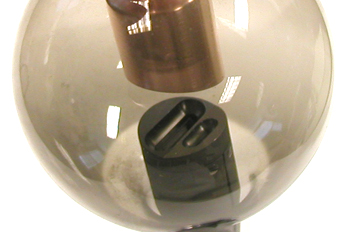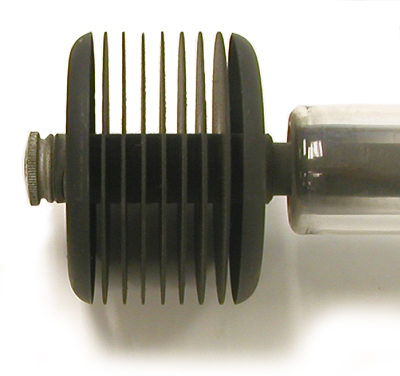General Electric RB-1-4 Radiator Tube (ca. 1935-1950)

This is the Model RB1-4 air-cooled double focus X-ray tube. Intended for diagnostic work, it was manufactured by General Electric (GE) at their Chicago facility. I believe that GE began manufacturing the RB1-4 in 1935 (see advertisement at bottom of page), but I don’t know how long the tube remained in production. Since this model was not mentioned in GE’s 1951 catalog, it seems reasonable to guess that this example was produced sometime between 1935 and 1950.
In the photo at the top of the page, the cathode is located on the right side of the spherical bulb while the anode (mostly copper) is towards the left.

The photo to the left is a close-up of the tube's tungsten cathode. Since this is a double focus tube, there are two filaments of different size. The smaller of the two was used when image detail was important. The larger filament would have been used when shorter exposures were required.
Since this tube takes advantage of the Benson line focus principle, the filaments are cylindrical spiral coils. In contrast, the single filament employed by the Model 3R was a concentric spiral sometimes described as a circle or cone.
The filaments probably operated at 3.5 to 5 amperes and 3.5 to 8 volts.
Perhaps the most obvious difference between this and the Model 3R radiator tube was the angle of the target. In the Model 3R, the target inclination was 45 degrees relative to the cathode. However, since the Model RB1-4 employed the Benson line focus principle, the angle was closer to 20 degrees. The purpose of the line focus was to improve the sharpness of the radiographic image without reducing the area of the target exposed to the electron beam (actual focal spot). Reducing the latter would improve the sharpness of the image, but the ability of the tube to dissipate heat from the target would be compromised No such compromise was necessary using a line focus. For a better explanation, check out the overview of Coolidge tubes.

The photo to the right shows the tube's radiator fins. The latter helped dissipate heat into the air.
A 1951 General Electric catalog strongly implied that the "RB" in another tube's model designation (the RB 2-4.5) referred to “round bulb.” I don’t know whether this was a joke, or whether they simply didn’t know the truth, but RB didn't stand for “round bulb.” The original version of the Radiator tube was known as the Model R. At some point in the 1920s, it seems to have become the Model 3R. (the 3 probably referred the fact that the bulb was three inches in diameter, but it might also have been related somehow to the focal spot size). In the early 1930s, GE replaced the tube’s circular filament with a cylindrical spiral filament that employed a Benson line focus. At this point it became the Model 3RB. As such, the “R” in “RB” stands for radiator and the “B” stands for “Benson.” The "1" in RB1-4 indicates that one of the filaments produced a fine focus while the "4" indicated that the other filament produced a broad focus.
The tube shown here is plugged into a rotary switch (optional when purchasing the tube) that selected which of the two filaments was to be used. The switch can be seen at the end of the cathode arm in the top photo.
The 1935 General Electric advertisement at the bottom of the page describes the tube as follows:
"Why sacrifice radiographic detail? This double focus Coolidge tube offers you the right size focal spot for the work in hand.
Observation shows that many X-ray laboratories attempt too wide a range of radiographic work with one and the same tube—expecting one size focal spot to serve them for both light and heavy exposures.
Regardless of whether this practice is an economy measure or to save the time of changing from one tube to another, the fact remains that far too often the resulting film represents a needless sacrifice in radiographic detail.
The RB-1-4 double focus Coolidge tube is the practical solution to this problem. It is the equivalent of two tubes, as it offers you the selective use of both a small and a large focal spot, by the simple turn of a switch. In other words, the right size of focal spot for the work immediately at hand.
It means economy, too, as RB-1-4 represents two Coolidge tubes in one, at the former price of one. Moreover, you will obtain the advantages of the Benson type (linear) focus, such as finer radiographic detail with greater energies; also tube construction which provides 25% greater heat storage capacity. $125.00"

Size: ca. 16 1/2" long (excluding rod for radiator fins), 3 3/4" bulb diameter
References
- General Electric X-ray Corporation. Coolidge X-ray Tubes - Kenotrons. Bulletin No. 293. 1934.
- General Electric advertisement. American Journal of Roentgenology and Radium Therapy. 1935.
- General Electric Catalog. X-ray Supplies and Accessories. 1953-1954.
